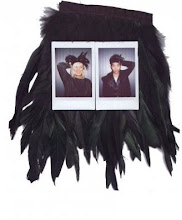This blog has been started from Stage 2. Stage 1 identified and located a gap in the market and the most viable progression for the brand to undertake. Stage 2 primary, secondary, qualitative and quantitative research is being continuously carried forward, ensuring each area is well anaylsed, to ensure coherence and suitability.
The Initial primary data was gathered during a four month internship from July to October 2008. Time spent there allowed insight into the structure and style as well as a thorough understanding of the brands USP and image. In terms of Promotion, insight was seen through procedures entailed producing the Summer 2009 womenswear show in Paris and the Adidas Summer collection event.
Primary research ran along side secondary research with focus groups and questionnaires as well as interviews. The consumers and industry specialists in Graphic and Fashion designer were targetted so that branding and style was ensured to be coherent. Potential target consumers selected in stage one will be interviewed throughout stage two to see what their perceptions of the projects developments throughout the marketing mix, through ethnographic studies are. This involved looking at the scientific descriptions of individuals behavior in society, leading to one to one conversations and observations within their every day surroundings. (The drawbacks in undertaking ethnographic studies is that they are time consuming and give limited sample sizes) However the advantages are that they provide a deeper profiling of consumers lifestyles, brands, relationships, design sensibilities and shopping dynamics.
Focus groups will also be undertaken allowing quick controlled feedback to explore broader conceptual themes. This gave participants the option to help resolve the issue that respondents tend to say what they think you would like to hear, not what they really feel.
Online testing was also be used to gain a wider net of opinions, due to being time and cost effective as well as flexible. To ensure purity of polling samples and inherent issues with quality control. Though the fact that design subtleties can be lost on screen, the above research methods are also being used.
Multidimensional competition case studies were undertaken to ensure competitors in the five different areas pointed out by Samil (1989) gain inspiration and develop innovative new ideas
Product and Service, communication and physical distribution
Horizontal competition
Vertical competition
Geographical dimensions - Store location and complexity of shopping environment
The nature of market competition
Competitor analysis will help form starting points in all areas of the Marketing mix, so that their strategy can be improved and adapted, as various elements and methods are needed to formulate and execute a marketing strategy. The target consumers needs are at the starting point of all aspects.
In order to be successful, an understanding of the varying nature of retail competition is required at each stage, in order to respond quickly and appropriately to stay ahead. Retail market research will be looked into through Fashion media publications such as Drapers Record and Mintel, as well as trend and lifestyle trend forecasting agency’s Stylesight, WGSN and Future laboratory. The purpose of industry insight and the continuous analysis of the economic climate will help try to stay ahead and anticipate changes in the business environment.
Throughout the market research Millman’s (2008) Golden Rules of Market Research will be taken into account.
Should be based on perceptions not preferences.
Make allowances for familiarity - consumers tend to be frightened of change.
Investigate emotional connections and design sensibilities. Avoid an over dependance on numerical imperatives.
Focus on what consumers like about the brand and product first, then ask them to focus on what design is communicating about brand/ product in general- avoid asking why they like it in design terms!
Never test designs in isolation- let them see a range of designs or next to competitors. Allows it easier for them to respond through comparing and contrasting.
Never ask how they would improve design you want their reactions not solutions.
Millman 2008: 31
NOTE
Through the duration of the project development the case study of - Absolute Vodka will be taken into account:
‘The absolute vodka bottle design was universally panned in focus groups. A courageous Michel Leroux, then the brand manager of the new vodka pressed for its launch the brand set international record sales. The bottle was considered a contemporary design icon.’
Millman 2008: 32
Giving consumers what they thought they wanted - design that is not likely to disrupt status quo however market research does not determine good design, the final decisions made in relation to the project will be made by industry specialists in design.
Friday, 8 May 2009
Subscribe to:
Post Comments (Atom)


No comments:
Post a Comment